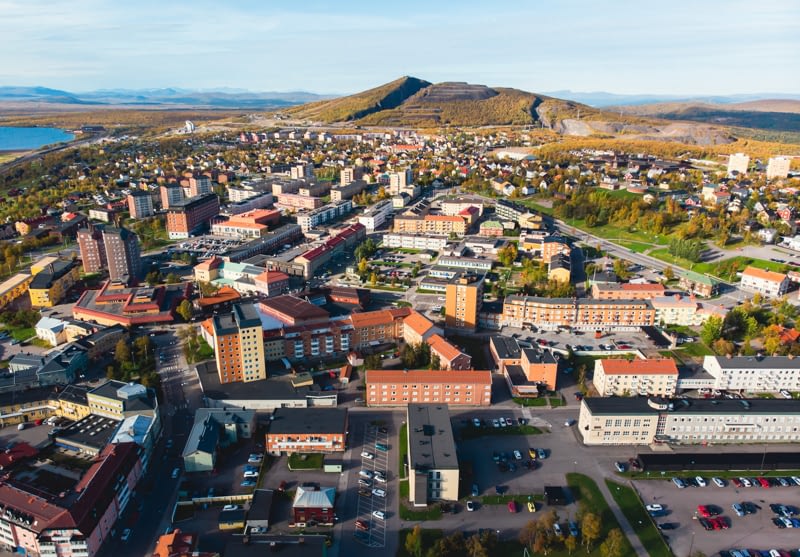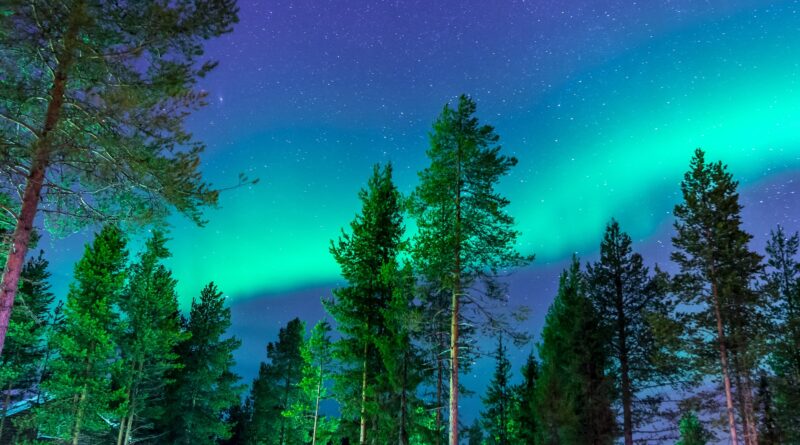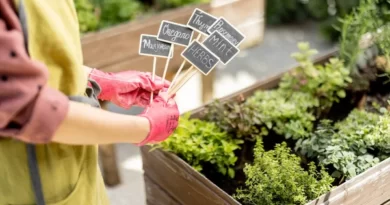What it’s like and what to visit in the Swedish city of the northern lights and the world’s largest iron ore mine
The town of Kiruna located in Swedish Lapland is home to a site whose excavations endangered the population and, the buildings were moved. A perfect destination to enjoy adventures a few steps away from the Arctic Circle.
The night closed, a cold that is losted at the bottom of any thermometer. Snow does not fall but covers everything. The sky is deep blue. The stars are like a bowling ball that crashed into the vault of heaven and shot the pieces to cover almost everything. As the hour penetrates the dawn, a natural electrocardiogram begins slowly to draw itself. Blues, violets, and greens in random ranges ripple from smallest to largest and cover an angle from the horizon that is gone in the center over your head.
The aurora borealis must have thrilled our ancestors. That magical situation could only be explained not so many years ago. When solar flares and explosions reach a certain intensity, this star launches a great number of particles into space. When they come to the Earth’s magnetic shield, they are attracted to an area around the North Pole, known as the auroral belt. There, they contact the upper atmosphere, the layers of ozone, oxygen, and other materials that protect the planet. The energy that is then released is what we see as the aurora borealis.
All this happens about 100 kilometers above our heads. The enormous energy charge of the auroras, which contain an infinite number of atoms and molecules, is the reason why they can be seen so clearly. They are as natural a phenomenon as the weather. Their appearance and intensity vary according to the sun’s activity and, their location depends on the Earth’s magnetic field.
Something similar to a particle detachment, but underground, is the experience that Kiruna, one of the best Swedish cities from which to observe the auroras, went through. The world’s largest iron ore mine is based there. It is settled in the far north of the country, very close to the Arctic Circle – owned by the Swedish state-owned company LKAB – is an example of sustainability, innovation, and efficiency. The mine digs to a depth of 1,365 meters and extracts the equivalent of six Eiffel Towers of ore every day.
At the beginning of this century, the city began to experience landslides. The undermining of the mine was eating away at the city from underground. A drastic decision was taken at that time: relocate the entire metropolis.

Packing up the buildings
In 2013 the plan had been prepared that, building by building, would relocate Kiruna. The diagrams were released and, with them, a town in the far north of Sweden would be relocated. An international competition was launched to relocate Kiruna in phases over 20 years. The winning proposal, drawn up by Arkitekter Blanco of Ghilardi + Hellsten, looked a century into the future to imagine a sustainable city with a diverse economy.
The process was arduous, slow, with extreme scheduling, and allowed for the piece-by-piece relocation of the buildings. Even from the 100+-year-old building housing the local museum that was transported five kilometers to a new location in the new Kiruna to the tiny traffic control booths.
If the relocation did not take place, much of the city was expected to collapse in an implosion within a couple of decades. Although most of the buildings have been demolished and rebuilt in the new location, many historic and culturally significant structures have had to be relocated, painstakingly using precision trucks, trailers, and electric tractors.
Although two-thirds of the town’s population is involved in the mine, the destination has become a tourist explosion. The mine managers spearheaded the process (and bore all the costs involved, including demolition, relocation, reconstruction, and compensation), selecting 20,000 locals to lead the effort. Some 3,000 landmark buildings weighing between 120 and 330 tons were dislocated and moved to their new locations without damage. Among them is the Kiruna church, which is a perfect expression of local architecture. The moving process will take until 2035 when the historic city will be closed for good.
Lappish life
The season that bids farewell these days is the season of the midnight sun. In August, darkness begins to creep in, the temperature drops, and suddenly autumn arrives and, destiny is painted in ochre. That autumn is a spectacle of color that makes you wonder about the diversity of that palette, especially when the Northern Lights make their entrance and illuminate the sky. Kiruna is considered the seat of Swedish Lapland.
At this time of year, when they have not yet received snow, it is possible to participate in sledding tours with Eskimo dogs. Already at the end of August, the northern lights can be seen in clear skies. Autumn is a perfect period to take pictures for Instagram, not only to the Northern Lights but also to the stars and the Milky Way. Taking the cable car to the famous Aurora SkyStation in Abisko may be the best plan. Icehotel 365 is open all year round. Its snow and ice art suites are admirable. Ice sculpting classes are held there. It is not possible to pass through Kiruna and not immerse yourself in the Sami culture. Meet the reindeer, taste the traditional Sami cuisine, and take refuge in a tent.
You can also pick up purple or red cranberries in a stress-free forest. Further, a guided tour is offered to discover the transformation process of the city and, it is also possible to visit the mine.
In addition to admiring the sky, Aurora Spa at Camp Ripan offers to recover some energy. Warm-up is one of the three saunas, rub yourself with birch leaves and iron ore pellets, float in the pool and philosophize about life. Although Kiruna is on a journey, its motto is to be present in the present. To let yourself be in the stillness of permanent movement and appreciate the hues of change. “Better to be on the move than still,” says Lappish wisdom.



